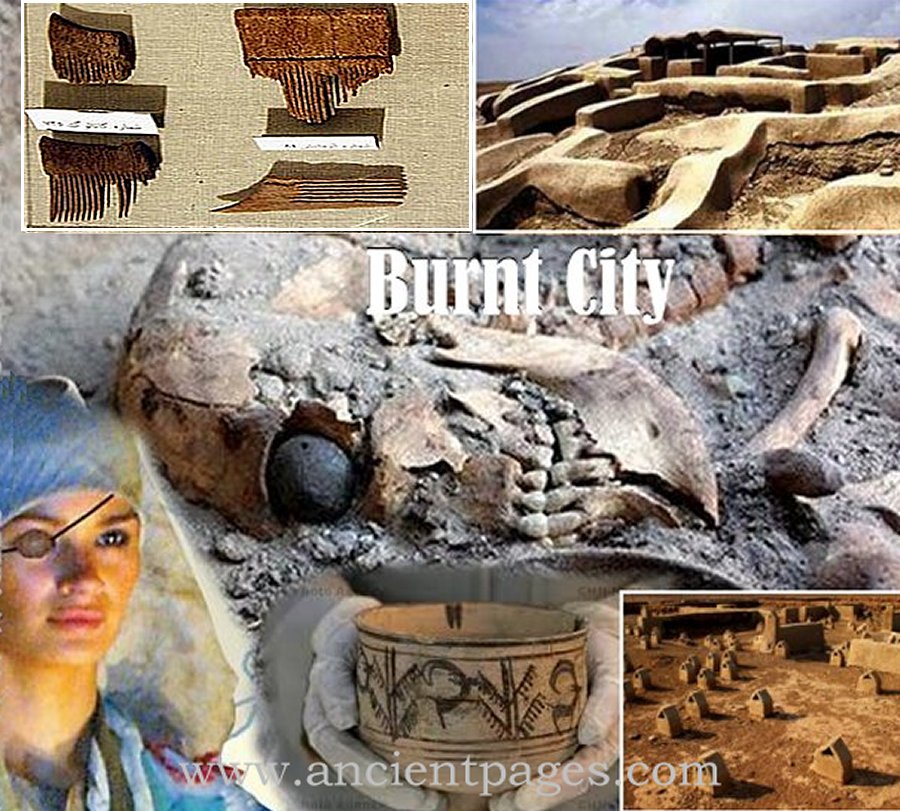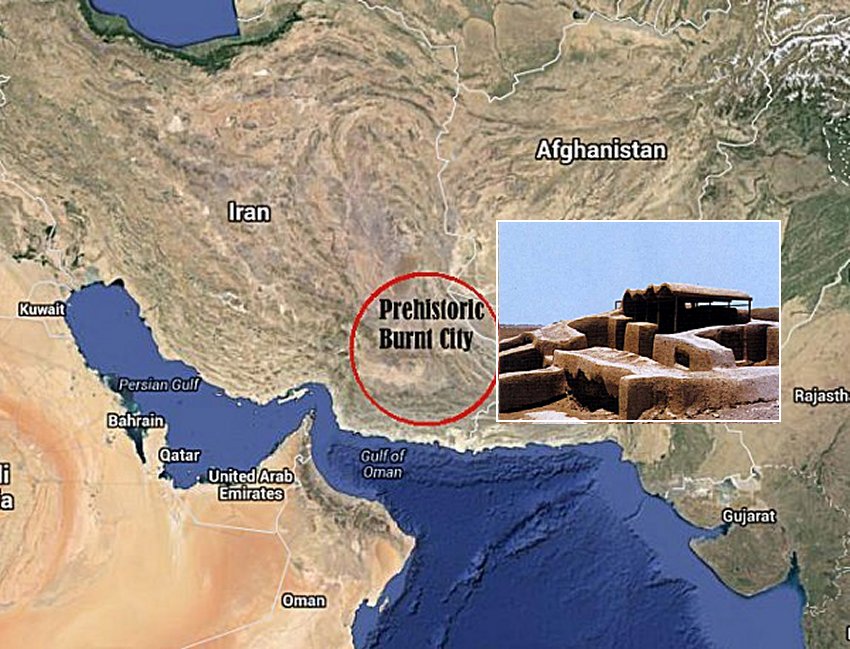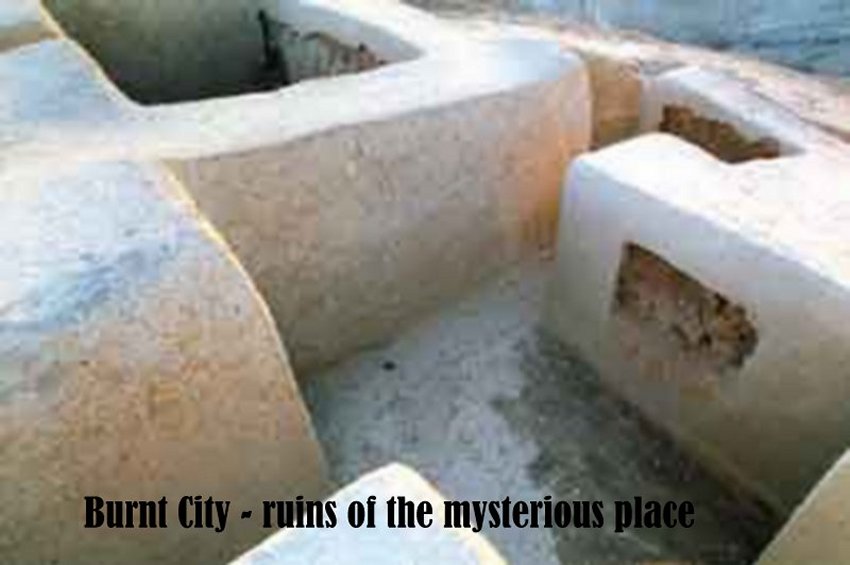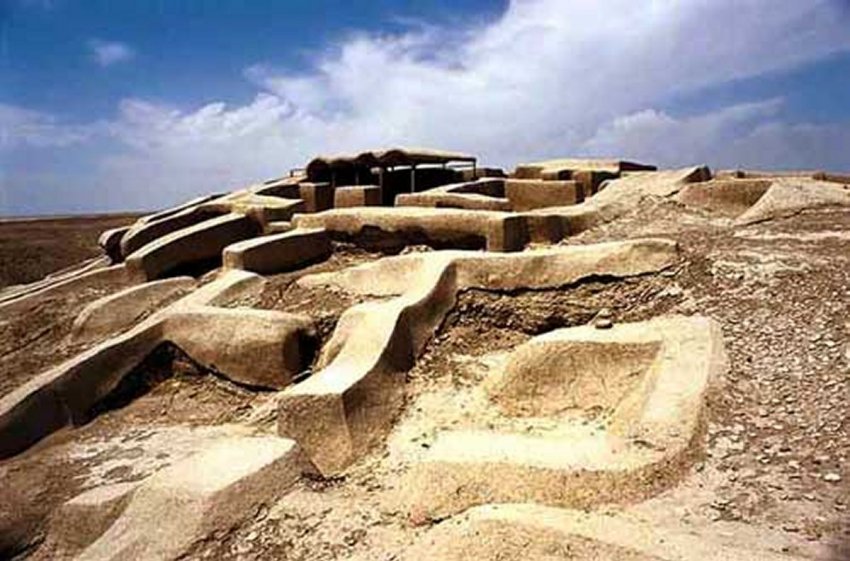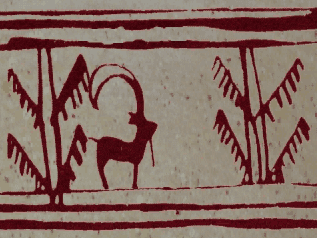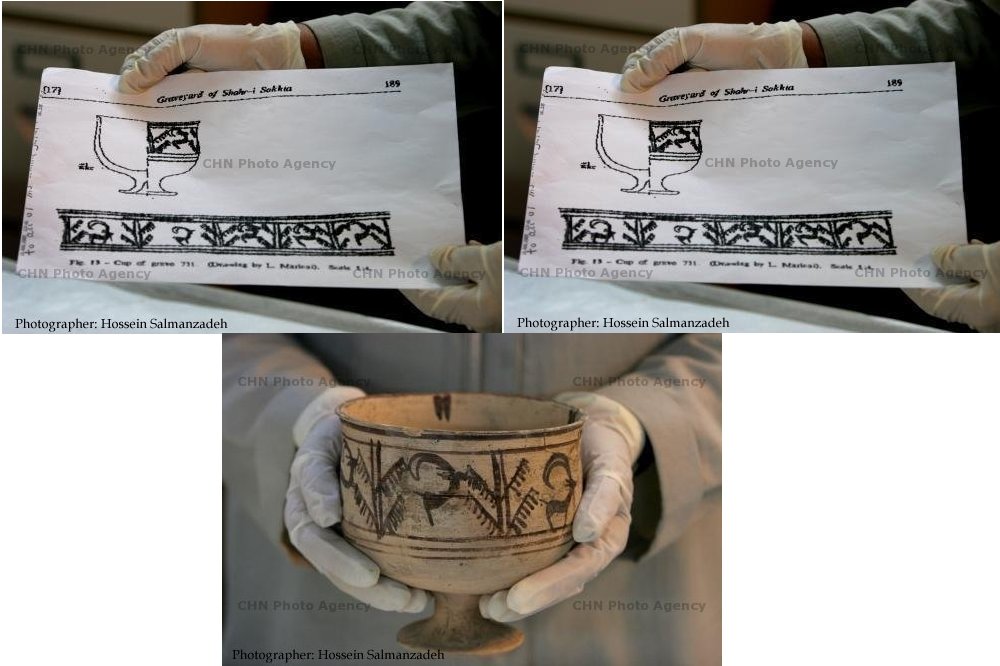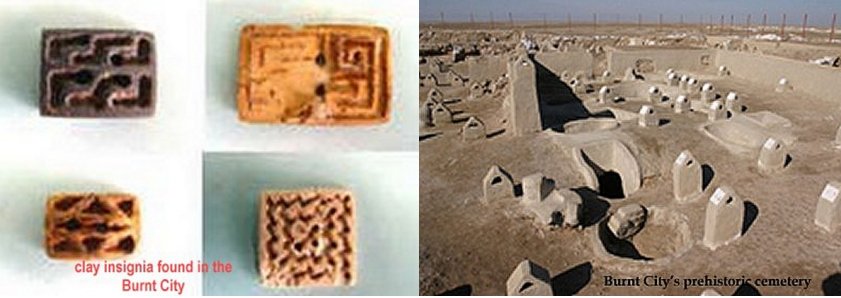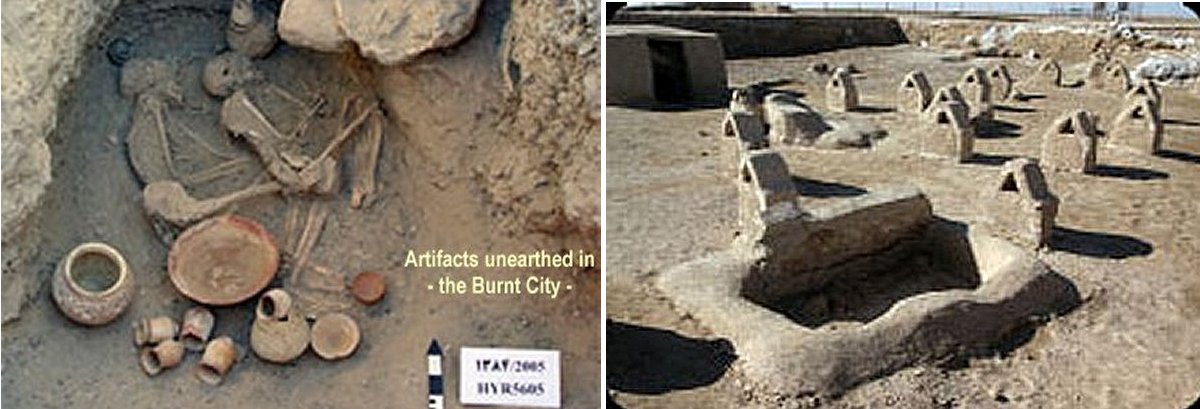Prehistoric Legacy Of The Mysterious Burnt City
A. Sutherland - AncientPages.com - Millennia ago, the Burnt City (Shahr-e Soukhteh) located in the southeastern province of Sistan-Baluchestan and bordering Pakistan and Afghanistan, was the largest city of Iran.
The history of the Burnt City, spanning over a 300,000-hectare area and its inhabitants has long baffled researchers.
Recently, archaeologists discovered an ancient grave of a 40-year old wealthy woman, containing 112 artifacts in the city, and the grave dates back to 4,600 years. has been discovered in the Burnt City and earlier, an Italian team had excavated 220 graves in the area, with three types of graves including simple ditches, ditches with two sections, and burial crypts.
The archaeologists and paleoanthropologists dug up over 600 skeletal remains buried in more than 108 graves.
Interesting is that after death, these people were buried in many different positions(!) Some were found lying on one-side, some were buried prostrate meanwhile the others maintained the supine position.
"A grave of 32- year-old man and his 10-year-old child, containing 112 relics, was discovered in the Burnt City in 1998," Mansour Seyyed Sajjadi, head of the Burnt City's Excavation Team informed.
Archaeologists and genetic specialists have conducted extensive studies on the ancient graves, the skeletons and a number of containers resembling collyrium box, colorful jars, and pieces of textile materials have been found near the skeleton.
This ancient place - one of the vital centers of Asian civilization in the Bronze Age - was an important converging point of such impressive prehistoric civilizations as Persia, Mesopotamia, India, and China in prehistoric times.
The Burnt City had all indispensable architectural structures, graveyards, central “downtown” and the town’s residential area. It was once the center of international trade. It flourished, had a good economy and the city’s skilled farmers cultivated seeds such as garlic, barley, caraway, wheat and grape.
The Burnt City that dates to the 4th and 3rd millennium BC unexpectedly appeared and then mysteriously disappeared.
There are ancient records that indicate the Burnt city's development in four stages. During its existence, the city was burnt down three times. Finally, it was abandoned and never rebuilt after the last cataclysmic fire around 2100 BC.
Is the city's name related to these prehistoric cataclysmic fires that totally devastated the inhabitants' place of living?
Based on the inventory of excavated artifacts in the area the residents of the city were peaceful people - mostly craftsmen and farmers. No trace of any ancient weapons was discovered.
This kind of plaster with mortar was used in masonry for covering a wall in order to strengthen the building against earthquakes and highly minimize the power of earthquake vibrations and preserve the structure from collapsing.
However, this particular architectural style is not entirely explained.
If the meaning with wood chips was to protect the buildings from earthquakes so: why was this style not applied in other constructions of the Burnt City like for example a prehistoric castle?
The site was discovered in 1967 and has been continually excavated since the 1970s by Iranian and Italian archaeological teams; new discoveries are occasionally reported.
Among many discoveries made at the site of the Burnt City are those related to the architectural style of the city's buildings, like for example, a 90-centimeter-wall has been found, on the surface of which, horizontal pieces of wood covered with some mud and mortar, were placed.
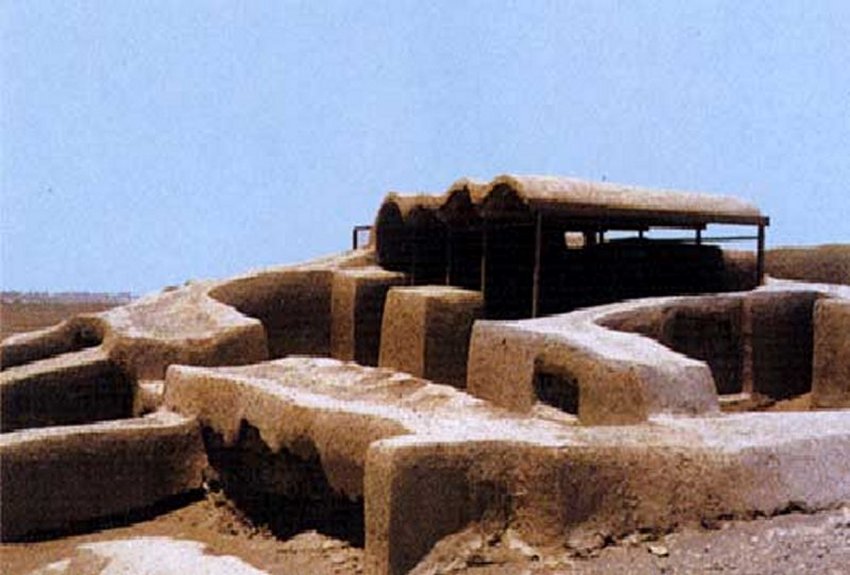
Studies show that in the early stage of their settlement in the region (3200 to 2800 BC) the Burnt City had trade contacts with the people in the Eastern and North-Eastern parts of the Greater Iran, Central Asia, and Quetta (in what is today known as Pakistan's Baluchistan).
Remains of various industrial workshops have also been found and all discovered artifacts like shards, ancient stone dishes, earthenware, and various pieces of cloth suggest the inhabitants of this prehistoric place were carpenters, hunters, knew weaving techniques, and made pottery.
They also knew secrets of metallurgy as a number of metallurgical finds were excavated. Among a variety of artifacts, there is also an original artifact in form of a game of backgammon composed of 60 pieces from turquoise and agate and a rectangular ebony board!
The artifact is claimed to be 100-200 years older than the one discovered in Mesopotamia.
"...The board is rectangular and made of ebony, which did not grow in Sistan, and merchants used to import it from India... the board features an engraved serpent coiling around itself 20 times, thus producing 20 slots for the game, more affectionately known in Persian as Nard. The engraving, artistically done, indicates artisans in the Burnt City were masters of the craft.
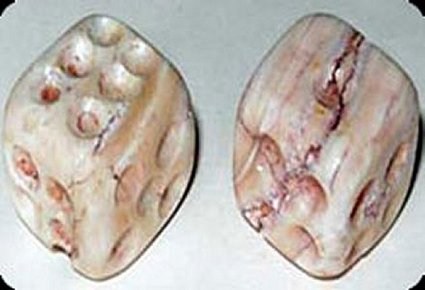
"The 60 pieces were also unearthed inside a terracotta vessel beside the board. They were made of common stones quarried in the city, including agate and turquoise," as Mansour Sajjadi, head of the research team described.
Another interesting discovery made in the city's ruins is an animated goat that jumps toward a tree and eats its leaves, portrayed on a small, earthenware bowl with a diameter of 8 cm and height of 10 cm.
Many pieces of pottery were discovered at the large site of archaeological diggings. Despite this, none of them contained images that implicated any movements.
Who was the anonymous creator of probably the world's first and oldest "animated" picture?
Yet another surprising artifact is a 10-centimeter ruler with an accuracy of half a millimeter(!).
Most often depicted on ancient earthenware, were fish and goat. Apparently, these two animal symbols were of special importance for the people of the Burnt City. It's still unexplained what they could mean.
Who was the anonymous creator of probably the world's first and oldest "animated" picture?
It is generally known that both fish and goats are among the most common mythological symbols and can be found in the folklore of many cultures.
What did the goat symbol express for the unknown inhabitants of the Burnt City?
Among the finest prehistoric pieces are necklaces made of gold and lapis lazuli and beautiful beads. All these true treasures indicate that the people who lived in the Burnt City possessed high technology for producing jewelry, too.
Most often depicted on ancient earthenware, were fish and goat. Apparently, these two animal symbols were of special importance for the people of the Burnt City.
Not long ago, the largest prehistoric cloth collection in the Middle East dated to 3000 BC was found in the Burnt City. Did these textiles belong to the women of the Burnt City?
According to the research, women living in the city had responsibility for the family finances. The theory is supported by about 5000-year-old insignias, made of river pebbles, discovered in the graves of some female residents of the city.
Most often depicted on ancient earthenware, were fish and goat. Apparently, these two animal symbols were of special importance for the people of the Burnt City.
Were the insignia used to authenticate some kind of valuable papers? Or were they only a part of women's personal possessions?
The archaeologists and paleoanthropologists dug up over 600 skeletal remains buried in more than 108 graves.
Interesting is that after death, these people were buried in many different positions(!) Some were found lying on one-side, some were buried prostrate meanwhile the others maintained the supine position.
This discovery would suggest the residents of the Burnt City could represent many different cultures, perhaps a prehistoric multicultural society.
Can all archaeological discoveries made in the area, shed some light on the mysterious, 5000-year-old past of the city?
Two years ago, researchers discovered 330 satellite villages located within a radius of 12 kilometers from Burnt City. The digging area turned out to be larger than previously expected.
Excavations were already conducted at the site in 15 seasons but the Burnt City's unclear past is truly baffling archaeologists.
It is difficult to get a picture of its mysterious inhabitants and reconstruct the city.
Can one day all archaeological discoveries made in the area, shed some light on the mysterious, 5000-year-old past of the city?
Written by – A. Sutherland - AncientPages.com Senior Staff Writer
Copyright © AncientPages.com All rights reserved. This material may not be published, broadcast, rewritten or redistributed in whole or part without the express written permission of AncientPages.com
Expand for referencesMore From Ancient Pages
-
 Treasures Of Polish Archaeological Dig In Czermno Medieval Fortified Settlement – Revealed
Archaeology | Dec 5, 2015
Treasures Of Polish Archaeological Dig In Czermno Medieval Fortified Settlement – Revealed
Archaeology | Dec 5, 2015 -
 Smallest Arm Bone In Human Fossil Record Illuminates Homo Floresiensis Origin
Archaeology | Aug 7, 2024
Smallest Arm Bone In Human Fossil Record Illuminates Homo Floresiensis Origin
Archaeology | Aug 7, 2024 -
 Ancient Maya Reservoirs Can Solve Today’s Water Crises – Scientists Say
Archaeology | Oct 10, 2023
Ancient Maya Reservoirs Can Solve Today’s Water Crises – Scientists Say
Archaeology | Oct 10, 2023 -
 Roman Marble Head Found In Lake Nemi Could Be From Caligula’s Legendary Ships
Archaeology | Jun 28, 2023
Roman Marble Head Found In Lake Nemi Could Be From Caligula’s Legendary Ships
Archaeology | Jun 28, 2023 -
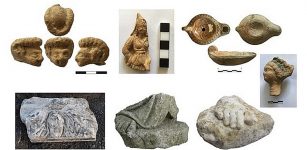 Excavations Of Ancient Theater In 2,400-Year-Old City Of Smyrna, Turkey
Archaeology | Feb 13, 2019
Excavations Of Ancient Theater In 2,400-Year-Old City Of Smyrna, Turkey
Archaeology | Feb 13, 2019 -
 1,600-Year-Old Pendants Depicting Humans And Animals Excavated In Ancient Port-City Of Assos
Archaeology | Jan 21, 2020
1,600-Year-Old Pendants Depicting Humans And Animals Excavated In Ancient Port-City Of Assos
Archaeology | Jan 21, 2020 -
 1,750-Year-Old Fresco Travertines Buried Underground – Recovered In Ancient Laodicea
Archaeology | Mar 19, 2020
1,750-Year-Old Fresco Travertines Buried Underground – Recovered In Ancient Laodicea
Archaeology | Mar 19, 2020 -
 Melisandre, The Red Woman: The History Behind Game Of Thrones’ Mysterious Mystic
Featured Stories | Jun 19, 2019
Melisandre, The Red Woman: The History Behind Game Of Thrones’ Mysterious Mystic
Featured Stories | Jun 19, 2019 -
 Early North Americans Much More Diverse Than Previously Believed
Archaeology | Jan 30, 2020
Early North Americans Much More Diverse Than Previously Believed
Archaeology | Jan 30, 2020 -
 Unique Find In A French Crypt Offers The First Evidence Of European Familial Embalming Dating Back To The 16th Century
Archaeology | Nov 20, 2024
Unique Find In A French Crypt Offers The First Evidence Of European Familial Embalming Dating Back To The 16th Century
Archaeology | Nov 20, 2024 -
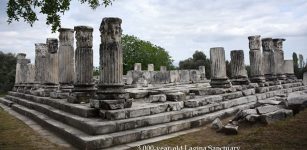 Lagina Sanctuary Of Goddess Hekate: Archaeologists Found Ceremonial ‘Sacred Road’
Archaeology | Jul 10, 2019
Lagina Sanctuary Of Goddess Hekate: Archaeologists Found Ceremonial ‘Sacred Road’
Archaeology | Jul 10, 2019 -
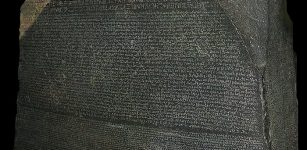 On This Day In History: Precious Rosetta Stone Found By Napoleonic Expedition To Egypt – On July 15, 1799
News | Jul 15, 2016
On This Day In History: Precious Rosetta Stone Found By Napoleonic Expedition To Egypt – On July 15, 1799
News | Jul 15, 2016 -
 Central European Early Iron Age ‘Hascherkeller’ Reveals Its Secrets
Archaeology | Jul 20, 2022
Central European Early Iron Age ‘Hascherkeller’ Reveals Its Secrets
Archaeology | Jul 20, 2022 -
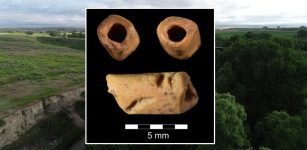 Oldest Bead In America Discovered At La Prele Mammoth Site, Wyoming
Archaeology | Feb 13, 2024
Oldest Bead In America Discovered At La Prele Mammoth Site, Wyoming
Archaeology | Feb 13, 2024 -
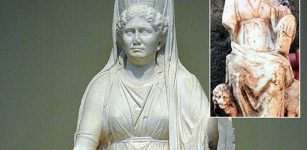 Marble 2th Century AD Statuette Of Goddess Cybele Unearthed In Bulgaria’s Plovdiv
Archaeology | Nov 5, 2019
Marble 2th Century AD Statuette Of Goddess Cybele Unearthed In Bulgaria’s Plovdiv
Archaeology | Nov 5, 2019 -
 Prehistoric Anomaly On The Tennessee-North Carolina Border Baffles Scientists
Featured Stories | Jul 30, 2024
Prehistoric Anomaly On The Tennessee-North Carolina Border Baffles Scientists
Featured Stories | Jul 30, 2024 -
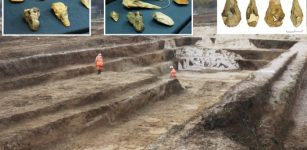 Rare Discovery: Giant Stone Artifacts Found On Ice Age Site In Kent
Archaeology | Jul 6, 2023
Rare Discovery: Giant Stone Artifacts Found On Ice Age Site In Kent
Archaeology | Jul 6, 2023 -
 Mystery Why Vikings Left Greenland Has Been Solved By Scientists
Archaeology | Mar 23, 2022
Mystery Why Vikings Left Greenland Has Been Solved By Scientists
Archaeology | Mar 23, 2022 -
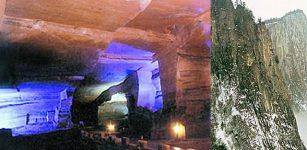 Incredible Technology In Mysterious Huashan Caves, China
Civilizations | Feb 10, 2015
Incredible Technology In Mysterious Huashan Caves, China
Civilizations | Feb 10, 2015 -
 Anansi The Spider: Trickster And Spirit Of Knowledge In African Mythology
African Mythology | Jul 20, 2016
Anansi The Spider: Trickster And Spirit Of Knowledge In African Mythology
African Mythology | Jul 20, 2016

